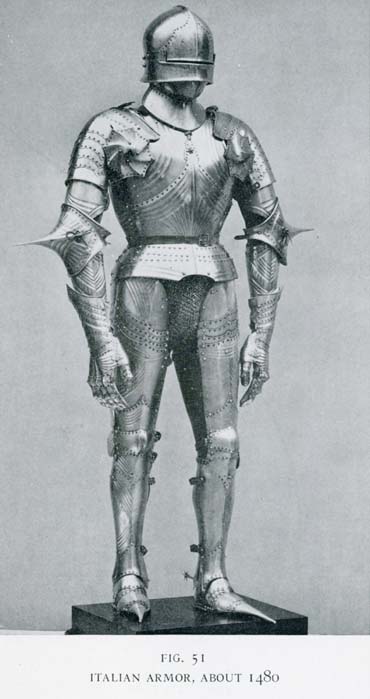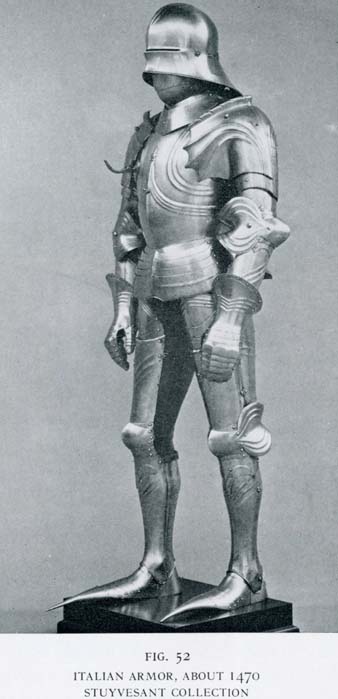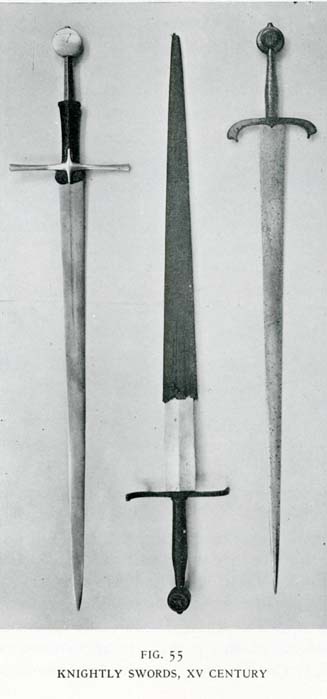
| myArmoury.com is now completely member-supported. Please contribute to our efforts with a donation. Your donations will go towards updating our site, modernizing it, and keeping it viable long-term.
Last 10 Donors: Graham Shearlaw, Anonymous, Daniel Sullivan, Chad Arnow, Jonathan Dean, M. Oroszlany, Sam Arwas, Barry C. Hutchins, Dan Kary, Oskar Gessler (View All Donors) |
| Author |
Message |
Chad Arnow
myArmoury Team


|
 Posted: Sat 31 Oct, 2009 10:58 am Post subject: Items no longer on display at the Met? Posted: Sat 31 Oct, 2009 10:58 am Post subject: Items no longer on display at the Met? |
 |
|
Hey folks,
I was perusing the 1930 Handbook to the Met recently and saw some interesting items pictured in it that I can't recall seeing on display when I was at the Met a few years ago. Some look (pretty) sketchy and may have been proven wholly or partially "fake" (term used loosely) since that book was published in 1930. Or maybe they just found better items to display.
Anyone know the stories behind any of these items?
 Attachment: 39.61 KB Attachment: 39.61 KB

"Italian", circa 1480. Looks fishy to me.
 Attachment: 35.63 KB Attachment: 35.63 KB

"Italian", circa 1470.
 Attachment: 25.31 KB Attachment: 25.31 KB

15th century swords. Again, somewhat sketchy (in varying amounts)
 Attachment: 36.91 KB Attachment: 36.91 KB

Harness, c. 1450. Looks pretty composite to me.

ChadA
http://chadarnow.com/
|
|
    |
 |
Dan Dickinson
Industry Professional

|
 Posted: Sun 01 Nov, 2009 11:53 am Post subject: Posted: Sun 01 Nov, 2009 11:53 am Post subject: |
 |
|
It looks like the sword on the left might be the inspiration for MRL's "Polish Sword".
What do you guys think?
Dan
|
|
  |
 |
Chad Arnow
myArmoury Team


|
 Posted: Sun 01 Nov, 2009 12:05 pm Post subject: Posted: Sun 01 Nov, 2009 12:05 pm Post subject: |
 |
|
| Dan Dickinson wrote: | It looks like the sword on the left might be the inspiration for MRL's "Polish Sword".
What do you guys think?
Dan |
You mean this one?



ChadA
http://chadarnow.com/
|
|
    |
 |
Dan Dickinson
Industry Professional

|
 Posted: Sun 01 Nov, 2009 12:22 pm Post subject: Posted: Sun 01 Nov, 2009 12:22 pm Post subject: |
 |
|
Yep, that's the one. I can't remember seeing any other actual examples (though if there are I'd be interested in seeing them).
Thanks,
Dan
|
|
  |
 |
Jared Smith

|
 Posted: Sun 01 Nov, 2009 4:06 pm Post subject: Posted: Sun 01 Nov, 2009 4:06 pm Post subject: |
 |
|
Maybe I am misunderstanding, but the old museum photo (possibly the basis of the "Polish sword") appears to have the cross guard mounted over a "rain guard" or whatever we might call this sort of extra leather protrusion. This seems different than our previous posts of reconstructions of similar leather flaps.
Absence of evidence is not necessarily evidence of absence!
|
|
  |
 |
Chad Arnow
myArmoury Team


|
 Posted: Sun 01 Nov, 2009 4:20 pm Post subject: Posted: Sun 01 Nov, 2009 4:20 pm Post subject: |
 |
|
| Jared Smith wrote: | | Maybe I am misunderstanding, but the old museum photo (possibly the basis of the "Polish sword") appears to have the cross guard mounted over a "rain guard" or whatever we might call this sort of extra leather protrusion. This seems different than our previous posts of reconstructions of similar leather flaps. |
Could be unless that's a scabbard remnant stuck under there (which I doubt).

ChadA
http://chadarnow.com/
|
|
    |
 |
|
Andrew Fox
Location: S.F. Bay Area Joined: 25 Jan 2004
Posts: 50
|
 Posted: Sun 01 Nov, 2009 4:24 pm Post subject: Posted: Sun 01 Nov, 2009 4:24 pm Post subject: |
 |
|
Museums don't always keep objects in their permanent collections forever. It's a misconception on the part of the public that museums are repositories of valuable stuff that never goes anywhere. Curators actively deaccession (a fancy museum word for "get rid of") objects that are not of high quality, fake, or just don't fit their personal vision for their collecting department.
Usually deaccessioned objects are offered to other museums, and if not taken are then offered on the open market through a major reputable auction house. Perhaps some of those suits of armor are in a private collection somewhere, or in another museum. I checked out the Met's collections database online, but their arms and armor section only seems to show the "greatest hits".
|
|
  |
 |
|
Danny Grigg
|
 Posted: Sat 07 Nov, 2009 8:40 pm Post subject: Posted: Sat 07 Nov, 2009 8:40 pm Post subject: |
 |
|
Chad
Does the 1930 Handbook to the Met have any pictures, information and dimensions on the European Axes, Badelaires and Flails that are shown in Stone's "A Glossary of the Construction...." book?
Figure 100 - European Axes (5 axes are shown). Are all 5 are from the Met or is just number 5, the Polish Axe that is from the Met?
Figure 107 - Badelaires (2 are shown, however I think the second example is a Falchion, not a Badelaire).
Figure 284 - Flails. (10 flails are shown. 2, 3, 4, 6, 9 & 10 are identified as being from the Met). Number 2 is the basis for A & A's #144 German Flail.
Thanks
Danny
|
|
  |
 |
Chad Arnow
myArmoury Team


|
 Posted: Sun 08 Nov, 2009 7:44 am Post subject: Posted: Sun 08 Nov, 2009 7:44 am Post subject: |
 |
|
| Danny Grigg wrote: | Chad
Does the 1930 Handbook to the Met have any pictures, information and dimensions on the European Axes, Badelaires and Flails that are shown in Stone's "A Glossary of the Construction...." book?
Figure 100 - European Axes (5 axes are shown). Are all 5 are from the Met or is just number 5, the Polish Axe that is from the Met?
Figure 107 - Badelaires (2 are shown, however I think the second example is a Falchion, not a Badelaire).
Figure 284 - Flails. (10 flails are shown. 2, 3, 4, 6, 9 & 10 are identified as being from the Met). Number 2 is the basis for A & A's #144 German Flail.
Thanks
Danny |
Danny,
This really has nothing at all to do with the thread at hand, so I'll respond via PM.

ChadA
http://chadarnow.com/
|
|
    |
 |
|
William Knight
Location: Mid atlantic, US Joined: 02 Oct 2005
Posts: 133
|
 Posted: Sun 08 Nov, 2009 10:26 am Post subject: Posted: Sun 08 Nov, 2009 10:26 am Post subject: |
 |
|
|
Well, none of those harnesses look like they belong together, so I suspect that the genuine piece have been broken up and may now be displayed individually.
|
|
  |
 |
|
Daniel Sullivan
|
 Posted: Sun 08 Nov, 2009 11:09 am Post subject: Posted: Sun 08 Nov, 2009 11:09 am Post subject: |
 |
|
Chad,
Really can't give any direct answers, but would like to make a few comments.
Edward's statement concerning museums selling of items to fund acquisition of others is right on the money. Several years back I knew first hand of a collection, containing a small display of arms and armor, that was liguidated by a curator whose interest was in modern art. Hate to think that the Met had so little monetary support that it would resort to this sort of thing. However, rotating exhibits and new material are what keep the contributors and paying customer interested.
Know of a local museum that had at least three suits of 16th century armor that appeared to be of German origin. I have inquired and was told they were in "storage", maybe. They were last displayed about twenty years ago, when parts of the Graz collection passed this way.
The Nelson-Atkins Museum in Kansas City (my home town) had four suits on display until recent years. Presently two 16th Century Italian suits, one with a rather incredible matching matching bard, are being shown. A "Gothic" suit has been dismantled and a few of its components are on display. It is illustrated, mounted, in their Handbook Vol.I, 5th Ed. 1973 as Spanish 1475-1490. I believe it to be Italian and composite. When young, always thought it to be the beauty of the collection...that feeling remains unchanged.
Be that as it may, even the Met makes mistakes. Just recently, it was discovered that two suits in their collection belonged to Henry VIII and not to Anne de Montmorency (Constable of France) and Galiot de Genouilhac (French Master of Artillery). For a very long time these pieces were mistakenly identified in several publications, i.e. Stone's Glossary, Arms and Armor (Grancsay) and Warriors and Worthies (Nickel). After all of these years what a discovery! Probably causes a bit of envy in our cousins across the pond.
The armor in fig. 51 looks German given the lack of tassets and extended upper plates of the cuisses, But to my eye the salade and bevor appear to be Italian. It appears in Stone's Glossary (1934and 1961) on p.27 as German Gothic. Tend to think that it may be a Victorian replica, perhaps a Schmidt piece. It just has a little bit too much of something, but I don't know what. Item 52, not even speculation here as I have only seen it illustrated in Met catalog of 1921.
Fig. 48 is pretty certain to be a composite, as the majority of this era are. On p.13 of Arms and Armor (Grancsay, 1964) the text states that it has a Milanese helmet and arm defenses. In Warriors and Worthies (Nickel, 1969) there is another view of this armor on p.56 with a simple caption, "Gothic armor, back view." both of these illustrations show the armor without the sabaton extensions shown in your post.
Love this sort of stuff and really appreciate this site for bringing it to me and others.....
Regards,
Dan
.
|
|
  |
 |
James Arlen Gillaspie
Industry Professional

Location: upstate NY Joined: 10 Nov 2005
Posts: 587
|
 Posted: Sun 08 Nov, 2009 11:28 am Post subject: Posted: Sun 08 Nov, 2009 11:28 am Post subject: |
 |
|
The genuine, relatively intact pieces of these armours are still on display. That leaves the first harness out of the running altogether. Any real parts it may have had have been messed with to perpetuate the overall decorative theme.
jamesarlen.com
|
|
   |
 |
|
|
You cannot post new topics in this forum
You cannot reply to topics in this forum
You cannot edit your posts in this forum
You cannot delete your posts in this forum
You cannot vote in polls in this forum
You cannot attach files in this forum
You can download files in this forum
|
All contents © Copyright 2003-2025 myArmoury.com — All rights reserved
Discussion forums powered by phpBB © The phpBB Group
Switch to the Basic Low-bandwidth Version of the forum
|

